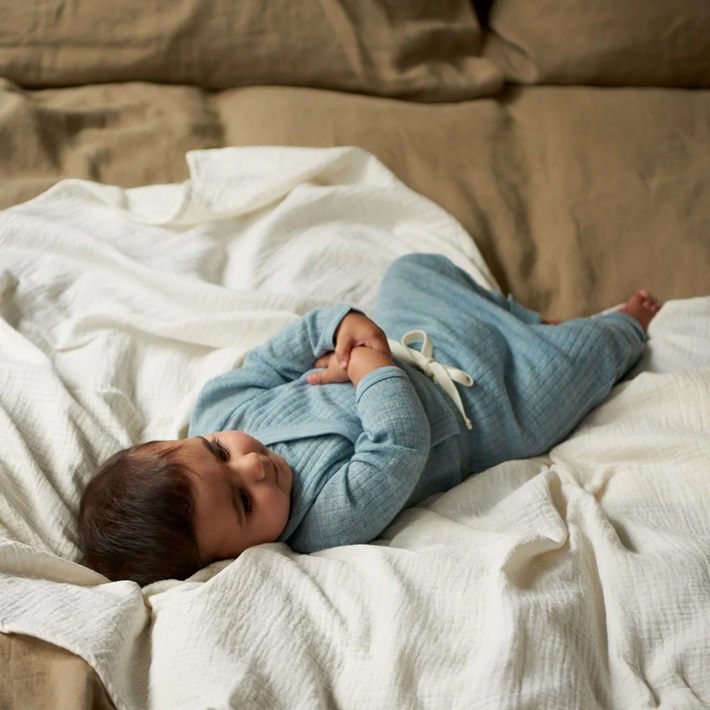Ensuring your little one is warm and comfortable is crucial, especially during colder seasons. One of the key aspects of providing adequate warmth to infants involves recognising subtle cues that suggest they might be feeling chilly. Signs such as cool skin, crying or fussiness, pale skin, increased irritability, shivering, decreased activity, changes in sleep patterns, and cool hands and feet could indicate that your baby needs additional warmth and attention.
To prevent this type of discomfort and create a cozy environment for your little one, you can try out some simple, yet effective methods. From dressing strategies to maintaining an optimal room temperature, these recommended practices aim to offer a comprehensive approach to keeping your little one warm, safe and content.
Layer Clothing
Layering clothing effectively traps warmth, ensuring your child stays cozy in varying temperatures. Start with a moisture-wicking base layer to keep their skin dry, add an insulating layer like fleece or wool, and finish with a weather-resistant outer layer. However, make sure that each layer isn’t too tight to restrict movement or too loose to pose a hazard. Choose soft, breathable fabrics to prevent overheating and check frequently for proper fit, avoiding loose cords or dangling accessories that may pose safety risks. Layering is an excellent strategy to keep your little one warm, offering flexibility and protection in changing weather conditions.
Use Woolen Blankets

Woolen blankets serve as exceptional companions in keeping your little one cozy and warm during colder months. Wool, a natural insulator, offers remarkable warmth while being breathable, making it an ideal choice for maintaining a comfortable temperature without overheating. The unique structure of wool fibres enables it to retain heat efficiently, providing a snug cocoon that insulates against the cold.
When selecting a woollen blanket for your child, prioritise softness and quality. Opt for a blanket made from fine, hypoallergenic wool to avoid potential skin irritation. Additionally, consider the blanket’s weight and thickness, ensuring it provides adequate warmth without feeling too heavy. If you are seeking a wool blanket for sale online explore reputable retailers specialising in bedding or natural fibre products.
Online marketplaces and stores dedicated to eco-friendly or natural materials often offer a variety of wool blankets suitable for children. Prioritise blankets made from organic or ethically sourced wool to ensure quality and sustainability. Always read product descriptions, customer reviews, and care instructions to make an informed purchase decision. A wool blanket is not only excellent for its thermal properties but also for its durability.
It has a remarkable ability to retain its insulating properties even when damp, making it suitable for various climates and conditions. Moreover, wool naturally repels moisture, making it resistant to mould and mildew, which is beneficial for your child’s health. Additionally, it’s inherently flame-resistant, providing an added safety advantage. However, it’s essential to check for safety certifications and labels to ensure the blanket meets necessary safety standards, especially when using it around young children.
A wool blanket is a fantastic choice to keep your little one snug and warm. Its natural insulating properties, breathability, and durability make it a reliable option for creating a cozy and comfortable environment while ensuring your child stays warm without overheating. Reputable retailers specialising in natural fibre products, both online and in physical stores, are excellent places to find a wool blanket for sale as they offer a variety of options to suit your preferences.
Maintain Optimal Room Temperature
Maintaining an ideal room temperature, typically between 20-22°C, is crucial for your child’s comfort. This range ensures a cozy environment without overheating or chilling them. Use a room thermometer to monitor and adjust the temperature accordingly, especially during sleep times or colder weather. Consider dressing your child in layers and using warm bedding if needed. Avoid drafts and sudden temperature changes. This optimal temperature fosters a comfortable space for your little one, aiding their relaxation, sleep quality, and overall well-being, creating an environment where they can thrive and feel secure.
Invest in Quality Outerwear

Investing in high-quality outerwear is pivotal for your child’s comfort and protection in colder climates. Opt for well-insulated winter coats, snowsuits, and boots designed to withstand chilly weather conditions. Seek waterproof and wind-resistant materials that effectively shield against snow and moisture. Inspect the clothing for proper fit, ensuring it allows movement without being too loose or restrictive. While quality outerwear may involve a higher initial cost, its durability and effectiveness in keeping your child warm make it a worthwhile investment. Reliable outerwear not only safeguards against the elements but also ensures your little one remains snug and content, allowing them to engage in outdoor activities comfortably and safely.
Offer Warm Beverages and Nutritious Meals
Providing warm beverages like herbal tea, hot chocolate, or warm milk offers comforting moments while helping maintain your child’s internal warmth. Combine these with nutritious, warm meals to enhance their overall coziness and well-being. Nutrient-rich soups, stews, or oatmeal not only offer warmth but also provide essential vitamins and minerals, boosting their immune system during colder seasons. Be cautious with temperature to prevent burns, serving beverages and meals at a child-safe warmth. This thoughtful combination of warm drinks and nourishing meals ensures physical warmth and creates a cozy ambience, fostering a sense of comfort for your little one.
Utilize Warm Baths

Utilizing warm baths for your little one before bedtime provides a soothing ritual that aids in relaxation and warmth. A comfortably warm bath helps prepare them for a restful sleep. Remember to keep the water temperature at a safe and warm level, around 37-38°C, and use gentle, baby-friendly bath products. This calming routine can also promote circulation and ease muscle tension. Incorporating warm baths into your child’s bedtime routine allows a cozy transition to sleep, facilitating a peaceful and comforting atmosphere. Make sure you’re there to supervise your child to ensure a safe and enjoyable experience.
Dress in Cozy Pyjamas
Dressing your baby in cozy pyjamas made of soft, warm fabrics ensures their comfort and warmth during sleep. That said, choose breathable materials when shopping for their attire, like cotton or fleece that provide insulation without overheating. Opt for footed or long-sleeved pyjamas for added warmth, ensuring a snug yet comfortable fit. Avoid clothing with strings or loose elements that might pose a risk. It’s also important to prioritise comfort and ease of movement to encourage quality sleep.
Avoid Overheating

Ensuring your little one stays warm is vital, but it’s equally crucial to prevent overheating, which poses serious health risks. While maintaining their comfort in colder weather is essential, excessive bundling or high room temperatures can lead to overheating. This condition may cause discomfort, and dehydration, and elevate the risk of Sudden Infant Death Syndrome (SIDS). With that in mind, pay close attention to signs of overheating such as sweating, flushed skin, or rapid breathing. Balance warmth with caution, dressing them appropriately and ensuring room temperatures are moderate. Ultimately, your child’s safety and well-being should be above all else.



